"Just be quiet, I'm saving your life," 38-year-old Jermaine Welch says the sheriff's deputy told him as he held Welch down on the ground.
Welch had flagged the officer down after being shot six times while driving through the intersection of Broadway and 86th Pl., just south of Manchester, a little after midnight on June 3. Adrenaline had propelled him the two and a half miles south to Imperial and Figueroa, but he was bleeding badly and starting to feel like he was falling into a deep sleep.
Now he was wondering if he should have just tried to keep powering through.
The deputy was asking about whether there were other passengers in his car. About whether he'd been associated with the group involved in the shooting at Broadway-Manchester. Then, while he was still being restrained, Welch says, he felt the officer fiddling with his hand and finally placing his thumb over his phone, as if to unlock it.
"They was trying to solve the crime rather than save my life," Welch says he remembers thinking before drifting into unconsciousness.
_______
This was not how things were supposed to end for Welch.
He had recently moved back to Los Angeles and was hopeful about the future he was building for himself and his young daughters. He had lost his hazmat job when the COVID-19 emergency hit, but continued doing deliveries for Weedies and was determined to use the extra time to get his side business, College Kids Apparel, off the ground.
Keeping himself on track was important. Not just for his own sense of self-worth, but because he often spoke to South Central youth who were going through the same struggles he had as a young man. For him to be able to convince them they had the power to take control of their own lives, he had to continue to set that example.
He'd even taken to the streets to lend his voice to the calls for justice in the wake of the May 25 murder of George Floyd by Minneapolis police officers (below). And although LAPD had fired rubber bullets his way at one of the marches, he would not be deterred. He had endured too much at the hands of law enforcement as a young man. He wanted the youth of his community to have a chance at a better life.

But when he later woke up from surgery on June 3, groggy, unable to speak, and in physical restraints, he quickly realized that for all the talk of reimagining public safety, LAPD still only saw Black men like him as a threat.
“Wow, I wake up from my death and it was like I was in jail...I’m treated like a criminal," he says. "[Yet] I'm the victim in this situation."
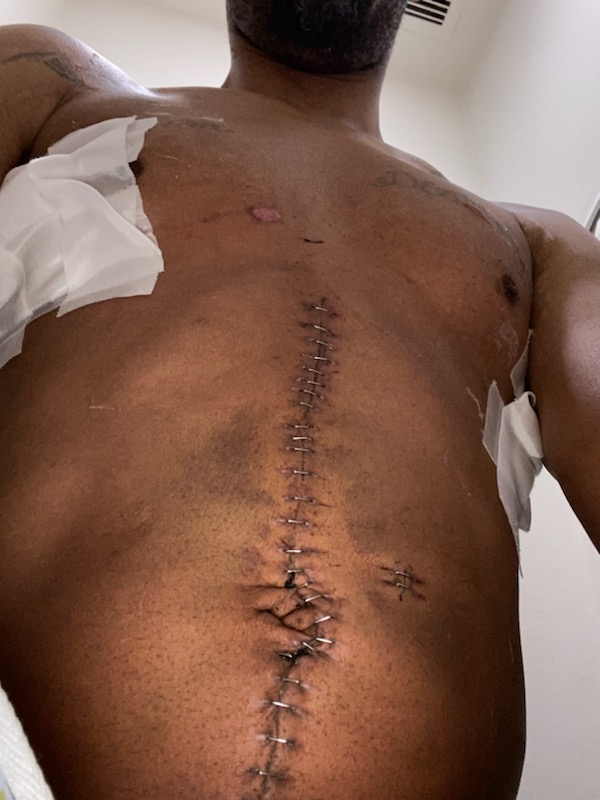
Medical staff later apologized for having restrained him. LAPD had told them that he was a suspect, he says.
Then LAPD had materialized at his bedside, asking if he remembered what had happened that night.
There wasn't much he could tell them.
He'd been out making deliveries for Weedies when he came upon a crowd of people gathered near the intersection of 86th Pl. and Broadway. He knew he'd heard someone yell, "F*ck the cops!," seen a bright light, and then been hit in the burst of shots that followed.
He knew that the intersection had then erupted in gunfire, but he'd had no idea where it was coming from or who was doing the shooting.
He knew his car had been sprayed - one bullet had burrowed in through his ribs, damaging his lung, while another had buried itself in his abdomen.
And he knew he'd thrown his right hand up in front of his face because the bullets had left his hand so badly mangled that the doctors had even raised the question of amputation.
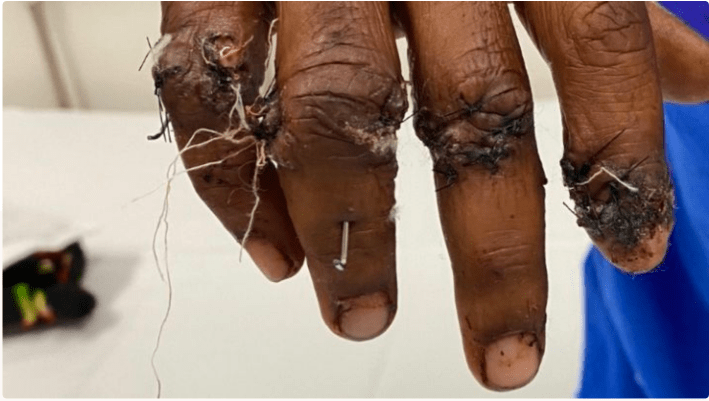
The officers didn't seem that interested in what he had to say, however, Welch recalls.
Nor did they seem to believe he had just happened to be passing through the intersection that night.
Nor were they willing to answer any of his questions.
The effort to tie him to some sort of wrongdoing didn't make sense to him. He was the victim.
It would have been very easy to verify he had been unarmed by checking his hands for gunshot residue, he says. And it would have been even easier to verify that he had been making deliveries that night by calling his employer (which, as of July 13, LAPD has yet to do).
Then Welch learned that not only had cops been on the scene that night, at least one officer had fired their weapon. Which meant that it was possible that he had been shot by an officer.
LAPD had something they needed to explain away.
_______
The obfuscation began almost immediately.
LAPD’s own 5 a.m. tweets on the incident described the officers as having come “upon a shooting in progress, at which point an Officer-Involved Shooting (OIS) occurred.”
Most news stories were similarly vague, describing a large gathering at the intersection, a report of shots fired, LAPD arriving to investigate, and an OIS “occurring.” Fox 11 added that “officers encountered a shootout between two groups...at which point an officer-involved shooting occurred." KTLA sprinkled in some drama, describing officers as having found themselves “smack in the middle of” a “really dangerous situation” at which point “an officer-involved shooting occurred.”
None of the outlets questioned how or why the OIS had “occurred” - what had prompted the shooting, who the officers had been shooting at, whether the officers had taken fire, what steps had been taken to safeguard bystanders from stray gunfire, or what measures the officers had taken to de-escalate the situation (or even to determine what was going on) before opening fire.
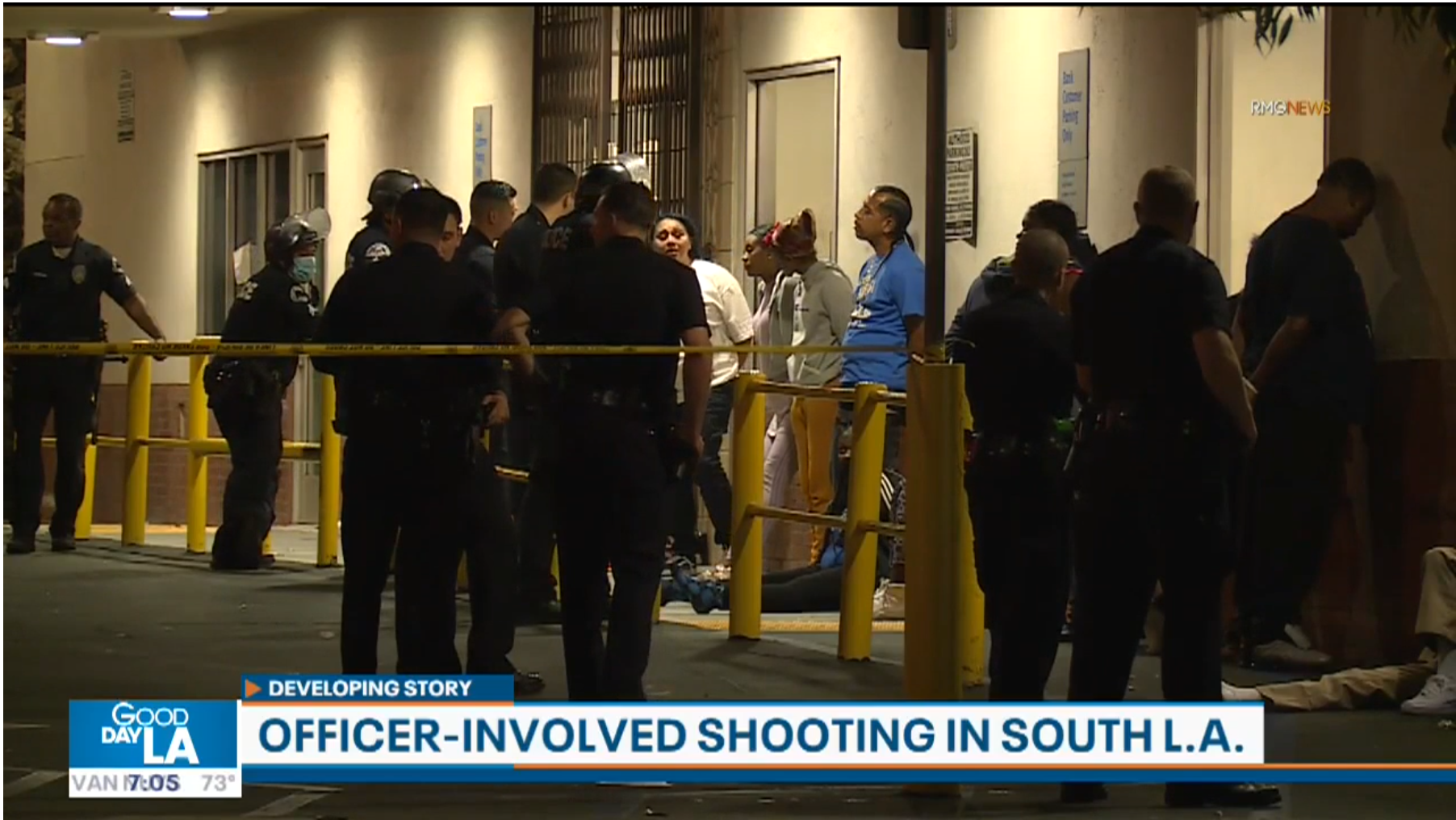
Shooting into crowds is not the kind of thing LAPD is allowed to get away with so easily in other neighborhoods.
In 2018, when officers killed Mely Corado after opening fire on an armed suspect that had fled into the crowded Silver Lake Trader Joe’s where Corado worked, LAPD tactics immediately came under scrutiny. The story remained in the headlines for months as the community clamored for justice in the face of the LAPD’s reluctance to be fully transparent about the incident.
More recently, LAPD's crowd suppression tactics and use-of-force practices have come under review, as officers were captured on camera firing rubber bullets at peaceful protesters, at an unhoused man in a wheelchair, and even at members of the press.
But in the case of the Broadway-Manchester shooting, reporters accepted the LAPD’s initial claims that the victims taken to the hospital were "involved or part of the group" that had participated in the shooting. It was a characterization that both implied they deserved any injuries they had incurred and played into stereotypes of the community as dangerous.
For LAPD, criminalizing those present on the scene had the added benefits of helping justify the decision to shoot into the crowd while discouraging follow-up questions. So it was no surprise that when the department put out a muddled official statement two days later saying officers “exit[ing] their vehicle were met by additional gunfire and muzzle flashes [from a shooting already in progress]" there was no further probing into why that immediately "resulted in an Officer-Involved-Shooting.”
None of which boded well for Welch.
_______
"They have my shoes," Welch says with frustration.
He’s not talking about just any shoes.
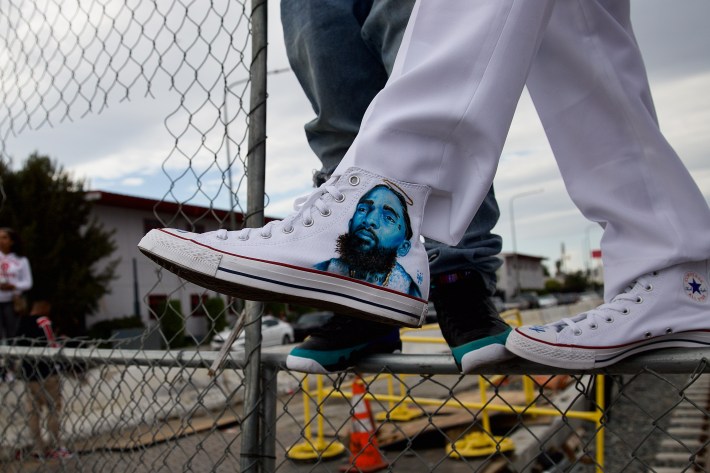
He had had his shoes custom painted with Nipsey Hussle's likeness in honor of the rapper’s passing in March of 2019.
When Welch first came across Hussle's "Bullets Ain't Got No Name" mixtape in a South Central market over a decade ago, the title had resonated with him. As a young man struggling to find his way forward, it spoke to both the reality he had lived and his understanding that staying in the streets would likely get him killed. As the years went on, he watched how Nipsey stayed true to himself and the people he came up with even as his fame grew, and had worked to model his own trajectory on Hussle's.
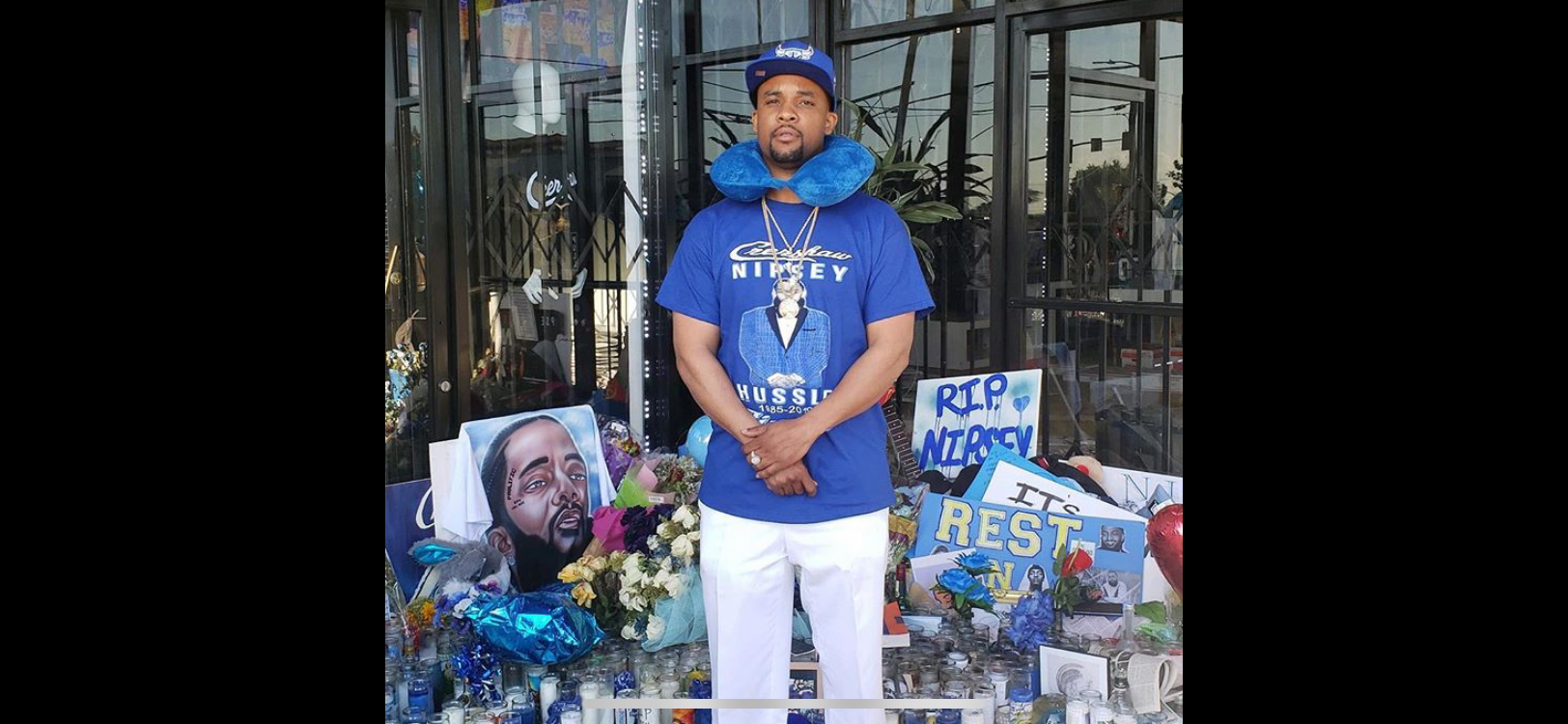
But LAPD had always viewed Hussle as just another gang-banger and done everything in their power to undermine his plans for Crenshaw and Slauson.
And now LAPD had those shoes - officers had taken them along with Welch’s other clothing, the bullets that had been lodged inside his body, and the $3,000 he'd collected while making deliveries. Were Nipsey's likeness and the words "Fly Crip" stenciled on the toes going to be cited as evidence of gang affiliation? Used to paint Welch as a threat to officers? Implicate him in a crime?
Welch didn’t know, but he wanted his Chucks back. So on June 25, he headed to the police station to ask about his personal property and the $3,000 he now owed Weedies.
He didn't get very far.
LAPD denied having the shoes.
Then they made him wait outside at least another half an hour before emerging with a search warrant and affidavit granting LAPD license to search his cellphone (which they still had possession of).
Welch shook his head as he read the warrant. Now he understood why he felt like the cops were taunting him while he waited.
He’d been lumped in with a number of other people listed as being connected to an attempted murder. Whether said attempted murder was his own, that of the other surviving victim taken to the hospital that night, or any of the other shootings that had happened in the area, Welch wasn't sure. But the fact that cops wanted to pick through his phone history (and the histories of eight other people) for the period between January 1, 2019 and June 17, 2020, however, suggested LAPD was now casting a very wide net.
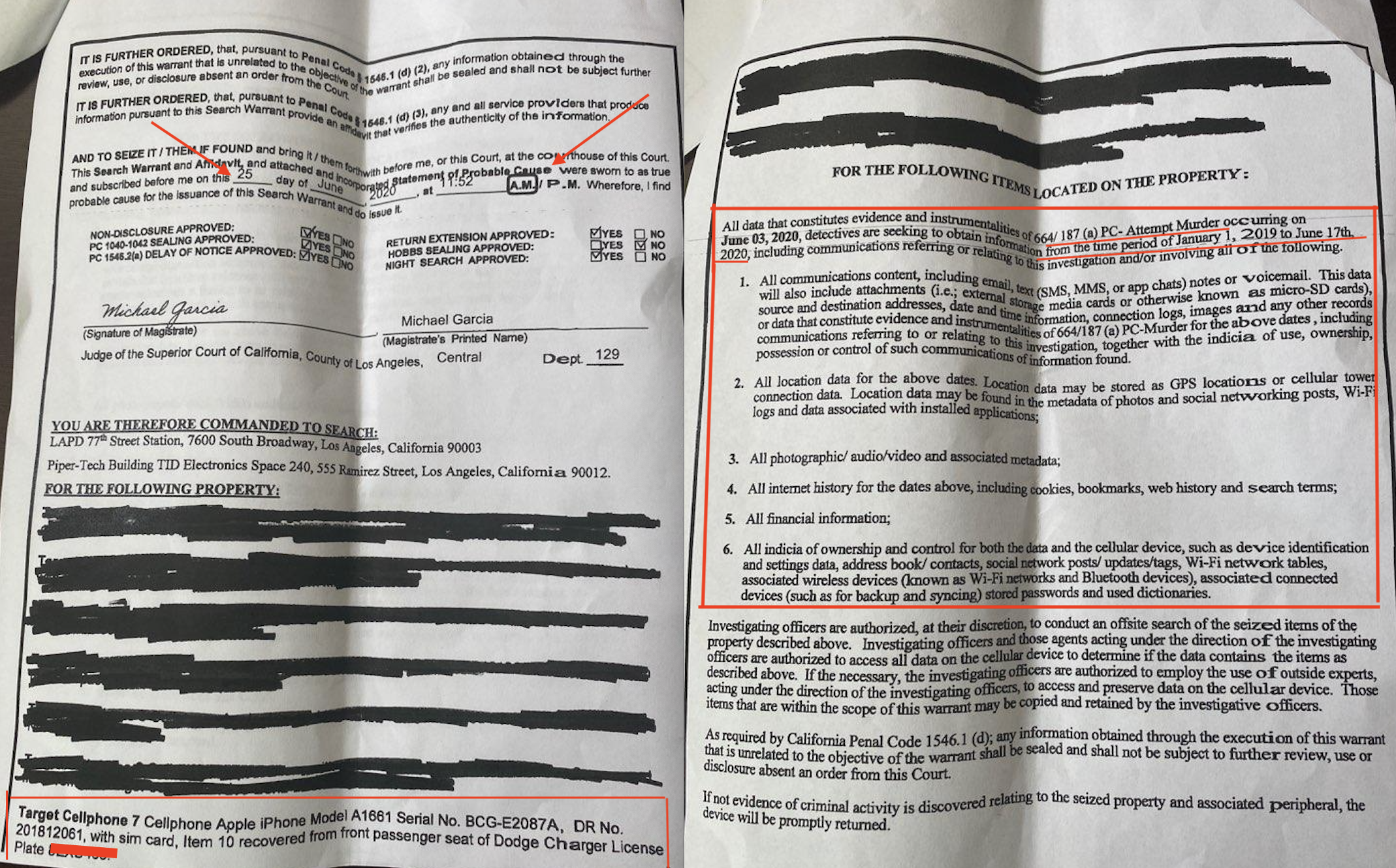
There is nothing incriminating in his phone, says Welch. The only "gang-related" messages LAPD might find have to do with the various ongoing peace processes he occasionally helps broker on the Eastside.
Clearly the first warrant - issued for his car on June 3 (below) - hadn't netted the LAPD whatever it was that they were looking for. That warrant had allowed LAPD to seek and confiscate weapons, ammunition, and anything that might appear to offer evidence of gang affiliation from five different vehicles that had been at the scene that night. But nothing was found in Welch's car except a spent bullet (to be expected, given that he was shot) and his phone (though Welch disputes this; he maintains his phone had been in his pocket).
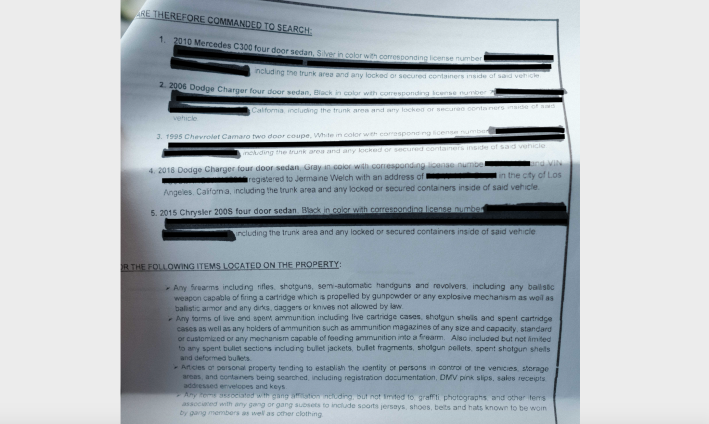
"It's really shocking how the cops are treating me," says Welch.
One of the reasons it's so hard to wrap his head around it, he says, is because when he got hit with those first bullets that night, he had actually wondered if the person shouting "F*ck cops!" had been yelling at him - if maybe the crowd had mistaken his Dodge Charger for an undercover police vehicle and subsequently opened fire.
It wasn't a likely scenario. But the idea that people in the community could be that enraged about the decades of profiling, criminalization, and brutality they had endured at the hands of LAPD at least made some logical sense to him.
Being framed for his own shooting, on the other hand, had not been on his radar. And it was creating a lot of additional stress that he did not need right now.
_______
Still traumatized by his brush with death, Welch has struggled to enjoy a peaceful night's sleep for more than a month now. The constant booming of fireworks sometimes triggers nerve pain, making it feel like he is "getting shot all over again," he says.
The fact that he is currently homeless and living in the same car in which he was shot - and which he was still cleaning the blood out of just last week - is not helping.
He had had an apartment before the shooting, but he was in the hospital so long that his roommate ended up stealing his more valuable stuff before abandoning the place altogether. The landlord changed the locks soon after.
He hasn't been able to get another place because the state recently drained his bank account for back child support payments, even though he had regularly been paying support informally via CashApp.
Meanwhile, his CashApp account was attached to the phone LAPD had, so he couldn't retrieve any funds or make any payments. And although he had reached out to the city's crime victim assistance program for help in getting back on his feet, they had not yet followed up on his claim.
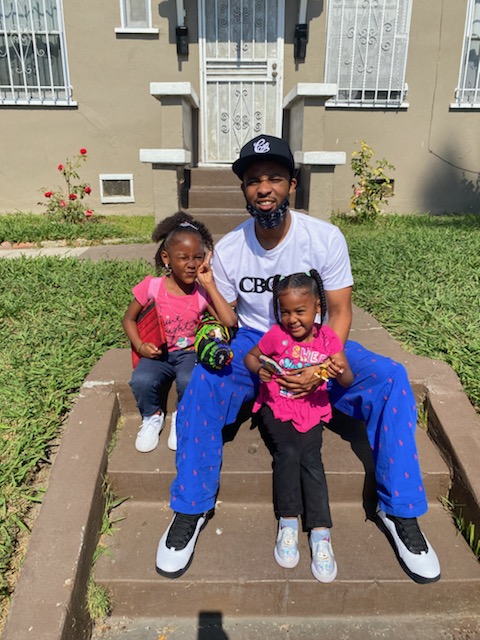
At one point, he'd tried to stay with a caretaker friend at her apartment in an affordable housing complex in Long Beach, but building security hassled her when he did, and he was afraid he'd end up getting her evicted.
"I have nowhere to go and the cops are everywhere," he says of never being able to feel safe.
The fact that his ability to escape this hellish limbo he's stuck in hinges, in great part, on law enforcement stepping up and doing the right thing is yet another stressor. He's had time to revisit all of the negative experiences he's had with both LAPD and the Sheriffs over the years, he says, and he's even less inclined to trust them now than he was before.
With good reason.
Although the department has made an effort to appear more open to seeing its own investigated and disciplined, when it came to the vicious beating of an unhoused Boyle Heights man by veteran officer Frank Hernández just this past April 27, LAPD faltered yet again. They couldn't resist making an explicit effort to paint the victim as the aggressor by feeding objectively false information to NBC4 the day before releasing the body cam footage.
In the case of the Broadway-Manchester shooting, LAPD has yet to release any body cam footage from that night (though it should be made available this week) or offer any additional clarification regarding the shooting or the investigation. And, somewhat unusually, the case has yet to be mentioned by Chief Michel Moore during his regular reports to the Police Commission. [Normally, it would have been mentioned at the June 10 meeting, but that day the commission focused its attention on the high-profile killing of Kenneth French inside a Costco by an off-duty officer. As best as I can discern, the incident has not been discussed at subsequent meetings.]
When this reporter called media relations for more information about the Broadway-Manchester incident, she was asked why she was describing it as an officer-involved shooting. Media relations' answer to an emailed request for more information was less defensive, but no more illuminating, unfortunately. The only addendum to LAPD's June 5 statement on the incident has been the June 11 update naming the officer who opened fire that night - Nathaniel Beck.
Beck was involved in an OIS in 2017, when he, Aaron Harrington (the officer who sought the June 25 warrant and affidavit on Welch's phone), and two other officers fired at José Castro, paralyzing him from the waist down. Castro had kidnapped his then-girlfriend, stabbed her, and then chased her with a knife as she tried to escape him. The shooting was found to be within policy and the officers were later honored for saving the life of Castro's victim.
Several years earlier, however, Beck and the LAPD were sued by the family of a middle-school student that had been sexually abused by Beck's then-wife, teacher Amy Beck, when the student was just fourteen. According to court documents cited in the L.A. Weekly, the suit alleged that (officer) Beck had “threatened that he would kill the [teen] victim with his police gun” after discovering them in his home and deducing that something inappropriate was going on. Beck was said to have repeated that threat to the boy's parents while using the boy's cellphone, which he later was alleged to have smashed. According to the L.A. Times, the suit also alleged that Beck had “shirked his mandatory duty” when he failed to report the molestation (the "guilt-ridden" Amy Beck ended up turning herself in to Burbank police at some later date after first resigning from the school without explanation), and that the LAPD had broken the law by failing to adequately “supervise, train or discipline” Beck.
With LAPD's investigation into the Broadway-Manchester shooting seemingly pointed outward rather than inward, Welch does not know if he will ever learn what role Beck had, if any, in his shooting. And he does not know what it will take for his own name to be cleared or for him to get his property back so he can get on with his life.
But he is determined to speak up about his case. Too often, folks have kept quiet when targeted by LAPD, both out of fear that their complaints would go nowhere and out of fear that raising their voice would invite retaliation. Welch is more than familiar with those stakes, but says he is not afraid. He knows he was the victim in this situation. And if there was ever a moment in time that his voice and his story might finally be heard, this was certainly it.
It's like that Nip Hussle song, says Welch. "Perfect timing."
_______
Jermaine has a new CashApp - $Collegekids26apparel - and welcomes any assistance as he gets back on his feet.
Previous coverage on the history of policing in the community via the story of Nipsey Hussle:
- April, 2019: South Central Gives Nipsey Hussle the Send-Off of a Lifetime
- August, 2019: City Attorney Keeps up Pressure to Evict Nipsey Hussle’s Legacy from Crenshaw and Slauson
- August, 2019: Nipsey Hussle Understood Cities Better than You
Find me on twitter: @sahrasulaiman







